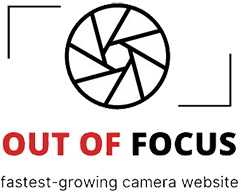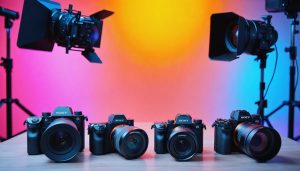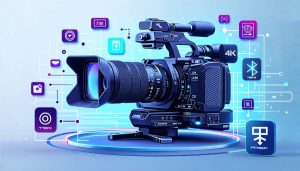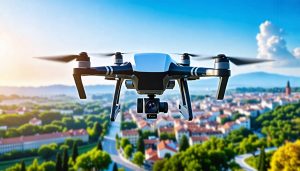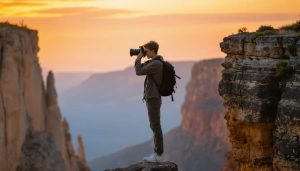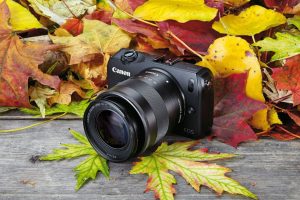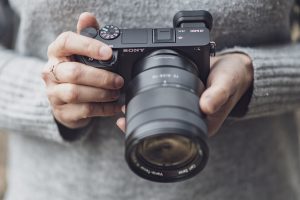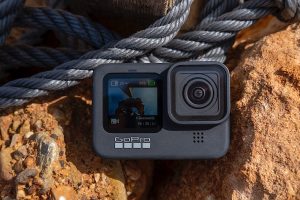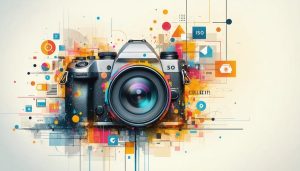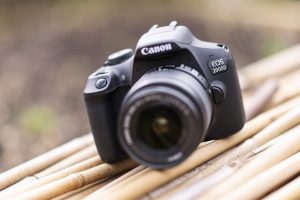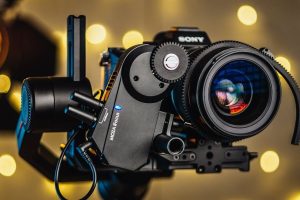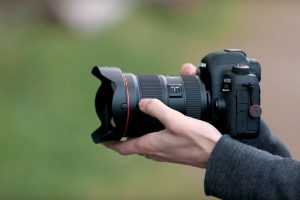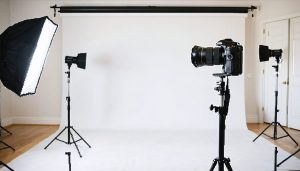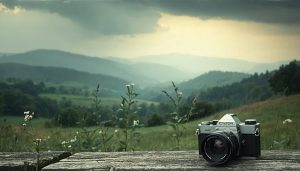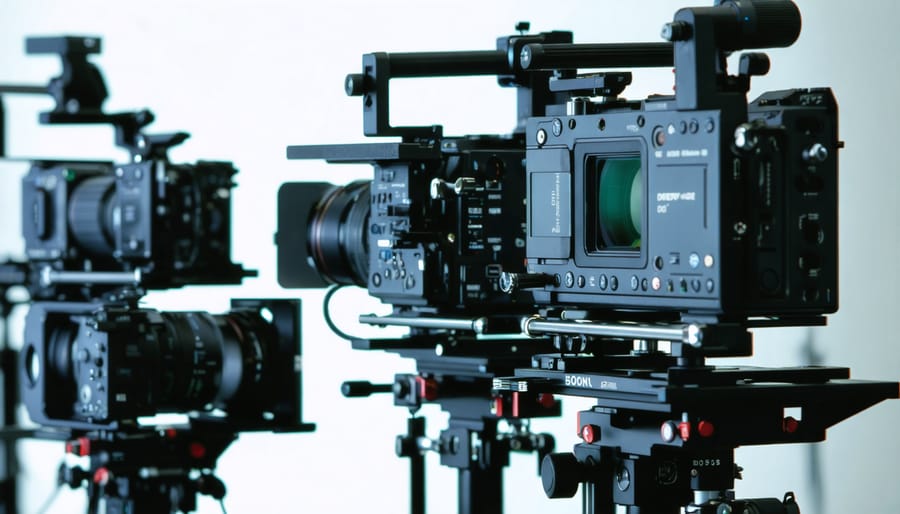
Professional cinematographers and filmmakers rely on three distinct tiers of video cameras, each serving specific production demands in today’s rapidly evolving digital landscape. From Hollywood blockbusters to television broadcasts, the evolution of video cameras has created clear divisions between cinema cameras like the ARRI Alexa and RED Komodo, broadcast-grade systems such as the Sony PXW series, and hybrid mirrorless cameras including the Sony FX6 and Canon C70. These professional tools share critical features: exceptional dynamic range, robust codec options, reliable cooling systems, and professional audio interfaces. While cinema cameras dominate high-budget productions with their uncompromising image quality and advanced features, broadcast cameras excel in live production environments, and hybrid systems offer remarkable versatility for independent filmmakers and content creators. Understanding these distinctions helps professionals select equipment that aligns with their specific production requirements and budget constraints.
Cinema Cameras: The Hollywood Standard
ARRI Cameras
When it comes to high-end professional filmmaking, ARRI cameras, particularly the Alexa series, stand as the gold standard in the industry. These cameras are the go-to choice for major Hollywood productions, prestigious TV shows, and high-budget commercials, capturing everything from “The Crown” to “Top Gun: Maverick.”
The ARRI Alexa’s popularity stems from its exceptional color science, which produces natural, film-like images that many cinematographers consider unmatched. The camera’s ability to capture up to 14 stops of dynamic range allows for incredible detail in both highlights and shadows, giving filmmakers tremendous flexibility in post-production.
The flagship Alexa 35 represents the latest evolution in ARRI’s technology, featuring a newly developed 4K Super 35 sensor that delivers outstanding low-light performance and enhanced dynamic range. Its modular design allows for various configurations, from stripped-down handheld setups to fully rigged studio arrangements.
What sets ARRI cameras apart is their reliability and consistent performance under demanding conditions. The robust build quality and intuitive menu system make them favorite tools among camera operators and cinematographers. While the price point (often exceeding $100,000) puts them out of reach for many, rental houses make these cameras accessible for specific projects.
The ARRI ecosystem also includes comprehensive support, from professional accessories to workflow solutions, making these cameras particularly attractive for large-scale productions where reliability and industry-standard compatibility are crucial. This complete system approach, combined with ARRI’s legendary image quality, explains why these cameras continue to dominate high-end professional video production.
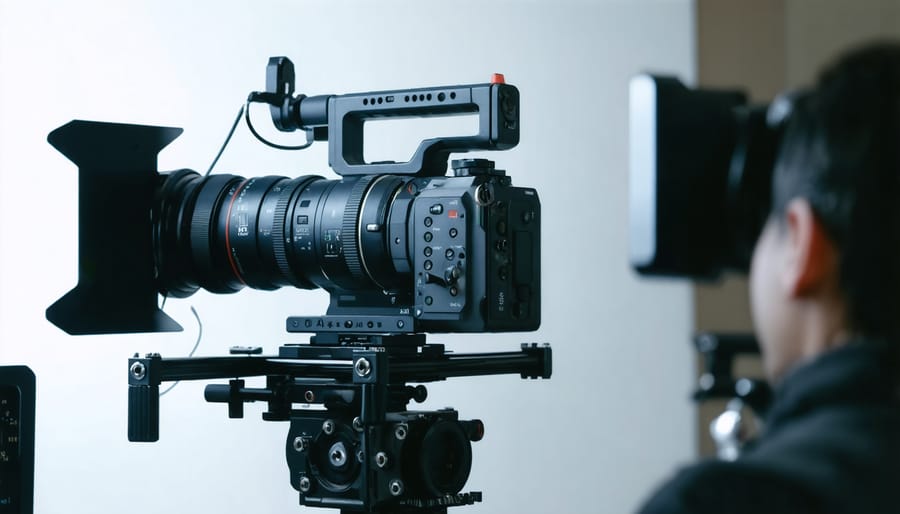
RED Digital Cinema
RED Digital Cinema has revolutionized the film industry since its debut with the RED ONE in 2007. Known for their exceptional image quality and innovative technology, RED cameras have become a staple in Hollywood productions, high-end commercials, and prestigious documentary projects.
The RED lineup includes various models, with the MONSTRO 8K VV and RANGER MONSTRO being among the most sought-after in the high-end cinema market. These cameras are renowned for their ability to capture stunning 8K footage with incredible dynamic range and color accuracy. The RED KOMODO, their more compact offering, has made RED’s technology more accessible while maintaining the brand’s signature image quality.
What sets RED cameras apart is their unique approach to sensor design and raw recording capabilities. They use a proprietary compression format called REDCODE RAW, which allows cinematographers to capture highly detailed footage while maintaining manageable file sizes. This becomes crucial during long shooting days or when working on feature-length productions.
Professional cinematographers choose RED cameras for several compelling reasons. The modular design allows for extensive customization based on shooting requirements, while the ability to capture high resolutions provides flexibility in post-production for cropping and stabilization. The cameras’ superior low-light performance and wide dynamic range make them particularly valuable for challenging lighting conditions.
Notable productions shot on RED cameras include “The Hobbit” trilogy, “Guardians of the Galaxy,” and “House of Cards,” demonstrating their versatility across different genres and production scales. While RED cameras come with a significant investment, their reliability and image quality make them a trusted choice for professionals who demand the absolute best in digital cinema.
Broadcast and Documentary Cameras
ENG/EFP Cameras
In the world of broadcast television and electronic news gathering (ENG), reliability and quick deployment are paramount. Sony and Panasonic dominate this space with their professional broadcast cameras, which are among the best video cameras for live events and news coverage.
Sony’s PXW series, particularly the PXW-Z750, stands as a flagship ENG camera, offering 4K capability, exceptional low-light performance, and robust built-in networking features. Its shoulder-mount design, essential for long periods of handheld shooting, comes with well-positioned controls that news operators can adjust without taking their eyes off the action.
Panasonic’s AJ-CX4000 delivers similar professional-grade performance, featuring a B4 lens mount and impressive dynamic range. These cameras include built-in ND filters, professional audio inputs, and SDI outputs – features that separate them from consumer-grade equipment.
What makes these cameras particularly suited for broadcast work is their ability to transmit footage directly to a news station via cellular networks or satellite uplink. They’re built to withstand harsh weather conditions and rough handling while maintaining consistent performance.
Both manufacturers have integrated their cameras with modern workflow requirements, supporting various codecs and recording formats that stations demand. While these cameras typically range from $15,000 to $35,000, their durability and reliability make them cost-effective investments for news organizations and production companies requiring daily, heavy-duty use.

Documentary-Style Cameras
Documentary filmmakers often gravitate toward cameras that combine durability, reliable autofocus, and excellent low-light performance with relatively compact form factors. The Sony FX6 has become a documentary workhorse, offering cinema-quality 4K footage in a lightweight body that’s perfect for run-and-gun shooting. Its dual-base ISO and built-in ND filters make it incredibly versatile across various lighting conditions.
Another popular choice is the Canon C300 Mark III, prized for its Dual Gain Output sensor and color science that delivers natural skin tones – crucial for documentary work. Its modular design allows documentarians to quickly switch between shoulder-mounted and handheld configurations.
For more budget-conscious productions, the Panasonic EVA1 offers a sweet spot of professional features and manageable size. Its 5.7K sensor downsamples to crisp 4K footage, while the dual native ISO helps capture clean footage in challenging light.
Documentary crews also frequently employ mirrorless cameras like the Sony FX3 or Panasonic GH6 as B-cameras or in situations requiring extreme discretion. These smaller cameras can capture footage in sensitive locations without drawing attention, while still maintaining professional quality standards.
Key features documentary filmmakers look for include:
– Extended recording times
– Robust audio inputs
– Weather sealing
– Quick-access controls
– Long battery life
– Fast and reliable autofocus
This combination of features ensures they can capture authentic moments without technical limitations getting in the way of the story.
Professional Mirrorless and DSLR Options
Sony Professional Lineup
Sony’s professional mirrorless lineup has revolutionized the video production landscape, with the FX series leading the charge. The flagship Sony FX9 stands out as a favorite among documentary filmmakers and independent producers, offering a full-frame sensor and impressive autofocus capabilities that rival traditional cinema cameras.
The FX6 has become particularly popular among run-and-gun videographers, combining professional features with remarkable portability. Its dual base ISO and S-Cinetone color science deliver stunning results in challenging lighting conditions, making it a versatile tool for everything from weddings to commercial productions.
For content creators seeking more affordable options, the Sony FX3 bridges the gap between consumer and professional gear. Building on recent hybrid camera innovations, it packs cinema camera features into a compact body while maintaining compatibility with Sony’s extensive E-mount lens system.
The A7S III, while technically part of Sony’s Alpha series, has earned its place in professional productions. Its exceptional low-light performance and 4K 120fps capability make it a powerful B-camera option for larger productions or a primary camera for solo operators.
Each model in Sony’s professional lineup offers distinct advantages, from the cinema-grade FX9 to the more accessible FX3, allowing filmmakers to choose the right tool based on their specific production needs and budget constraints.
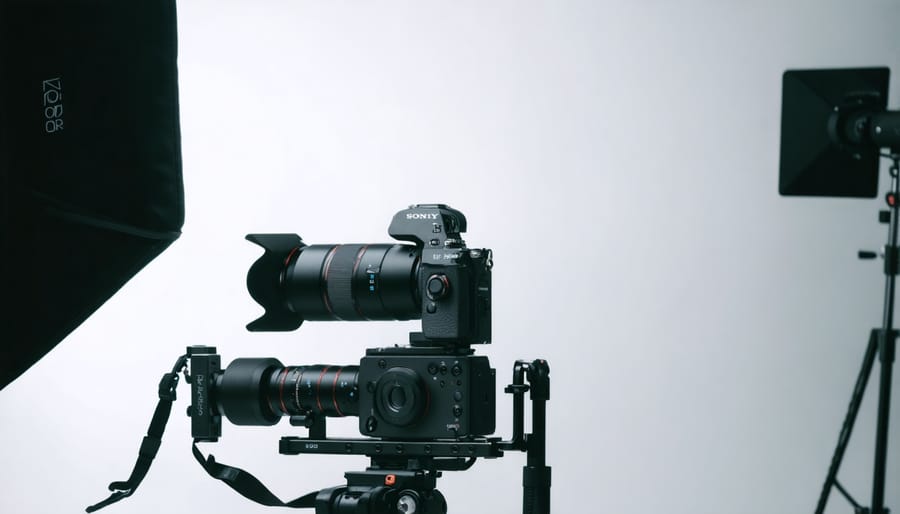
Canon Cinema Line
Canon’s Cinema Line represents the company’s dedicated professional video production ecosystem, with the C-series cameras standing at the forefront of their offerings. The flagship Canon C700 FF delivers full-frame excellence for feature films and high-end productions, while the C500 Mark II offers a more compact alternative without compromising on image quality.
The mid-range C300 Mark III has become a favorite among documentary filmmakers and television producers, thanks to its versatile Dual Gain Output sensor and impressive dynamic range. This camera strikes an excellent balance between portability and professional features, making it particularly suitable for run-and-gun shooting situations.
For independent filmmakers and content creators, the Canon C70 serves as an interesting bridge between cinema cameras and mirrorless systems. It incorporates Cinema EOS features into a compact body that’s more familiar to DSLR users, while still maintaining professional-grade video capabilities.
All Cinema Line cameras share Canon’s renowned color science, which has become an industry standard for skin tones and natural color reproduction. They also feature built-in ND filters, professional audio inputs, and robust recording options including Canon RAW Light and XF-AVC formats.
These cameras are designed for professional workflows, with features like built-in timecode, proxy recording, and compatibility with professional accessories. While they represent a significant investment, their reliability and image quality have made them staples in professional production environments.
Key Features That Make a Camera ‘Professional’
Video Formats and Codecs
Professional video cameras support various formats and codecs, with the choice often depending on the production requirements and post-processing workflow. Most high-end cameras can shoot in RAW format, which captures uncompressed data directly from the camera sensor technology, providing maximum flexibility in post-production.
Common professional codecs include ProRes (Apple’s professional codec), XAVC (Sony’s format), and Blackmagic RAW. These formats balance quality with manageable file sizes, making them practical for professional workflows. Many cameras also offer compressed options like H.264 and H.265 for less demanding projects or when storage space is limited.
Resolution options typically range from 4K to 8K, with some high-end systems capable of 12K capture. However, the bitrate and color depth are often more crucial than pure resolution. Professional cameras usually offer 10-bit or 12-bit color depth and high bitrates (anywhere from 100Mbps to 2000Mbps) to ensure smooth gradients and better color grading potential.
Most professional cameras also support various aspect ratios and frame rates, from standard 16:9 to anamorphic 2.39:1, and frame rates from 23.98fps up to 120fps or higher for slow-motion footage. This flexibility allows cinematographers to achieve their creative vision while meeting technical broadcast or theatrical distribution requirements.
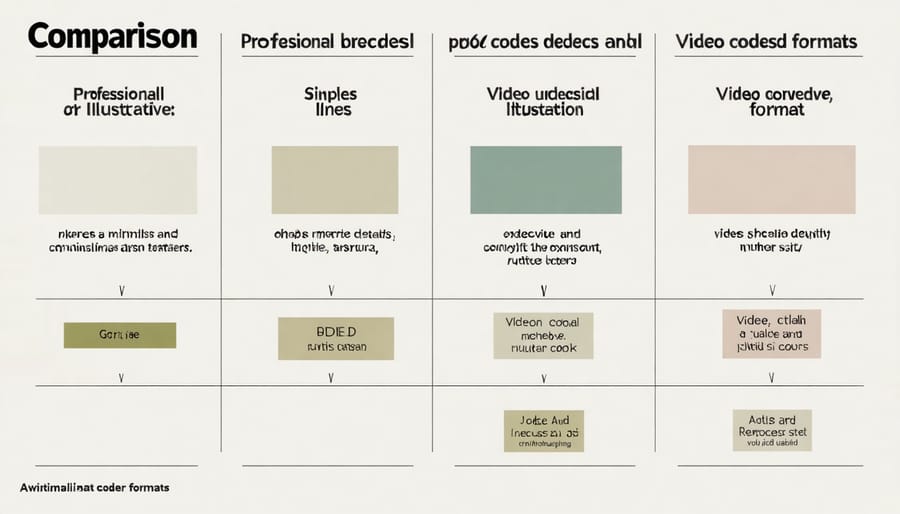
Professional Audio and Connectivity
Professional audio quality is just as crucial as video in professional productions, and high-end cameras reflect this in their audio capabilities. Most professional cameras feature multiple XLR inputs, allowing direct connection of professional microphones and audio mixers. These balanced connections ensure clean, noise-free audio recording even with long cable runs on set.
Many cinema cameras like the ARRI ALEXA and RED cameras support multi-channel audio recording with adjustable gain controls and phantom power for condenser microphones. They also offer advanced audio monitoring options with dedicated headphone outputs and on-screen audio meters for precise level monitoring.
Connectivity is another crucial aspect of professional video cameras. Standard features include SDI outputs for sending uncompressed video signals to external monitors or recorders, timecode input/output for synchronization in multi-camera setups, and genlock for broadcast environments. Modern cameras also incorporate wireless capabilities for remote control via smartphone apps and quick file transfers.
Professional cameras typically include a variety of mounting points for audio accessories, making it easy to attach wireless receivers, shotgun microphones, and mixer panels. Many also feature dedicated audio control buttons for quick adjustments during shooting, eliminating the need to dive into menus while recording.
Most importantly, professional cameras offer clean HDMI or SDI outputs without overlays, essential for external recording and live broadcasting scenarios.
Cost vs. Capability Analysis
When it comes to professional video cameras, the relationship between cost and capability isn’t always straightforward. High-end cinema cameras like the ARRI ALEXA or RED cameras can cost upwards of $40,000, but they deliver unmatched image quality, dynamic range, and color science that’s essential for major film productions. These cameras offer features like RAW recording, built-in ND filters, and sophisticated cooling systems that justify their premium price point.
In the mid-range segment ($15,000-30,000), cameras like the Sony FX9 and Canon C300 Mark III offer an excellent balance of features and affordability. These cameras provide professional-grade capabilities like 4K resolution, high frame rates, and robust codec options, making them popular choices for documentary filmmaking, corporate video production, and independent films.
The sweet spot for many professionals lies in the $5,000-15,000 range. Cameras like the Blackmagic URSA Mini Pro and Sony FX6 deliver remarkable value, offering features previously only available in higher-end systems. These cameras often provide 90% of what most professionals need at a fraction of the cost of cinema cameras.
Entry-level professional cameras ($2,000-5,000) like the Panasonic GH6 and Sony FX30 have revolutionized the industry by making professional-quality video accessible to emerging filmmakers. While they may lack some premium features, they’re capable of producing broadcast-quality footage in the right hands.
When analyzing cost versus capability, consider these factors:
– Production requirements and deliverables
– Rental versus ownership costs
– Supporting equipment needs (lenses, accessories)
– Post-production workflow compatibility
– Return on investment potential
Remember that the most expensive camera isn’t always the best choice for every project. Many successful professionals choose mid-range options and invest the savings in quality lenses, lighting, and audio equipment, which often have a more significant impact on the final product than the camera body alone.
Choosing the right professional video camera ultimately depends on your specific needs, budget, and production requirements. While high-end cinema cameras like the ARRI ALEXA and RED cameras remain the gold standard for feature films and big-budget productions, many professionals are finding excellent results with more accessible options like the Sony FX9 or Canon C300 Mark III.
For those starting their professional journey or working in corporate video production, hybrid cameras like the Sony A7S III or Panasonic GH6 offer remarkable capabilities at more manageable price points. Remember that professional results come not just from the camera itself, but from understanding how to maximize its features and combining it with quality lenses, lighting, and sound equipment.
Consider your typical projects, delivery requirements, and workflow when making your choice. Documentary filmmakers might prioritize portability and low-light performance, while commercial shooters may need higher frame rates and resolution options. Whatever your choice, invest in a system that you can grow with and that integrates well with your existing equipment.
Don’t forget that many successful professionals own or rent different cameras for different projects. Sometimes, the best approach is building a versatile kit that includes a main workhorse camera supplemented by specialized equipment for specific shooting scenarios.
